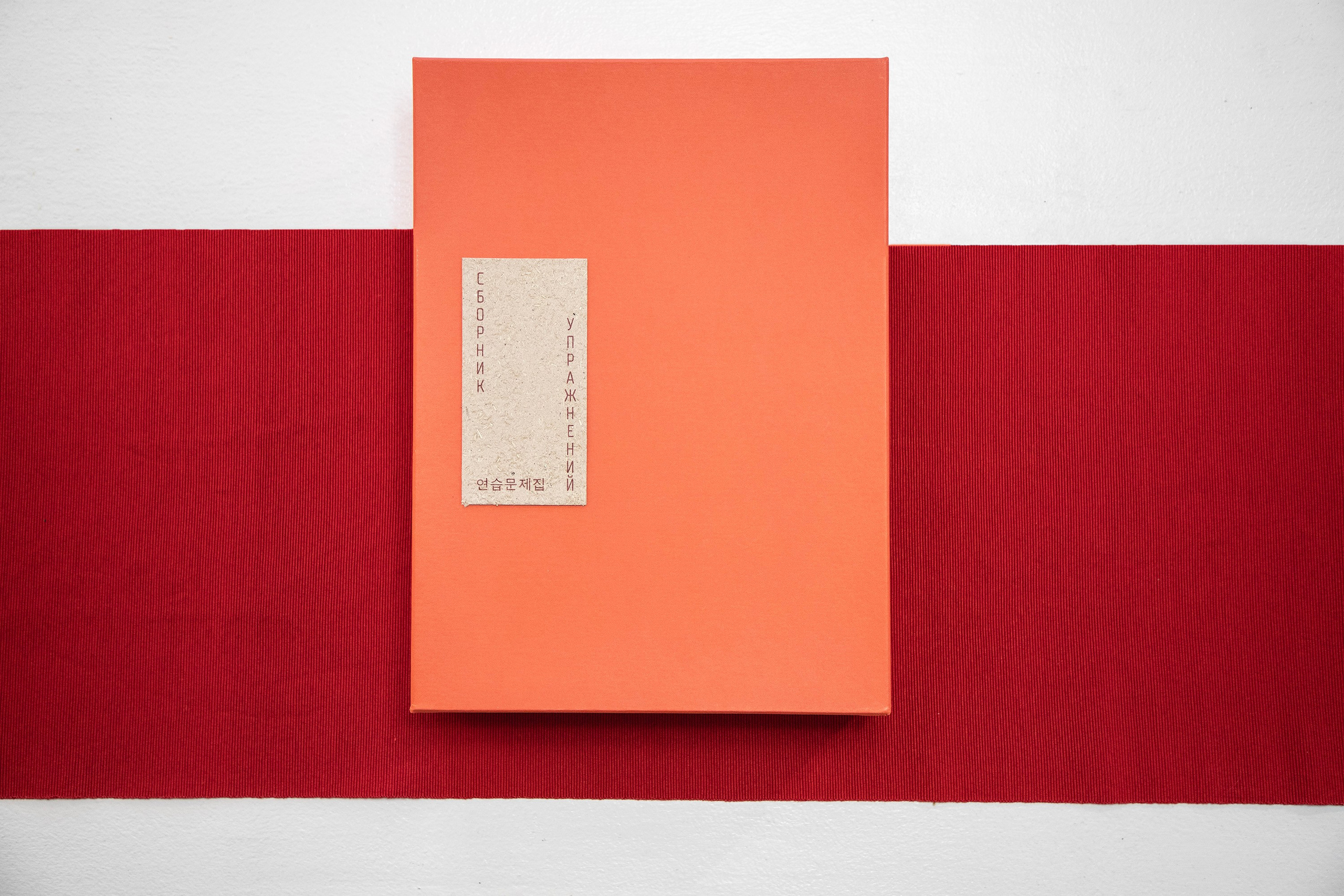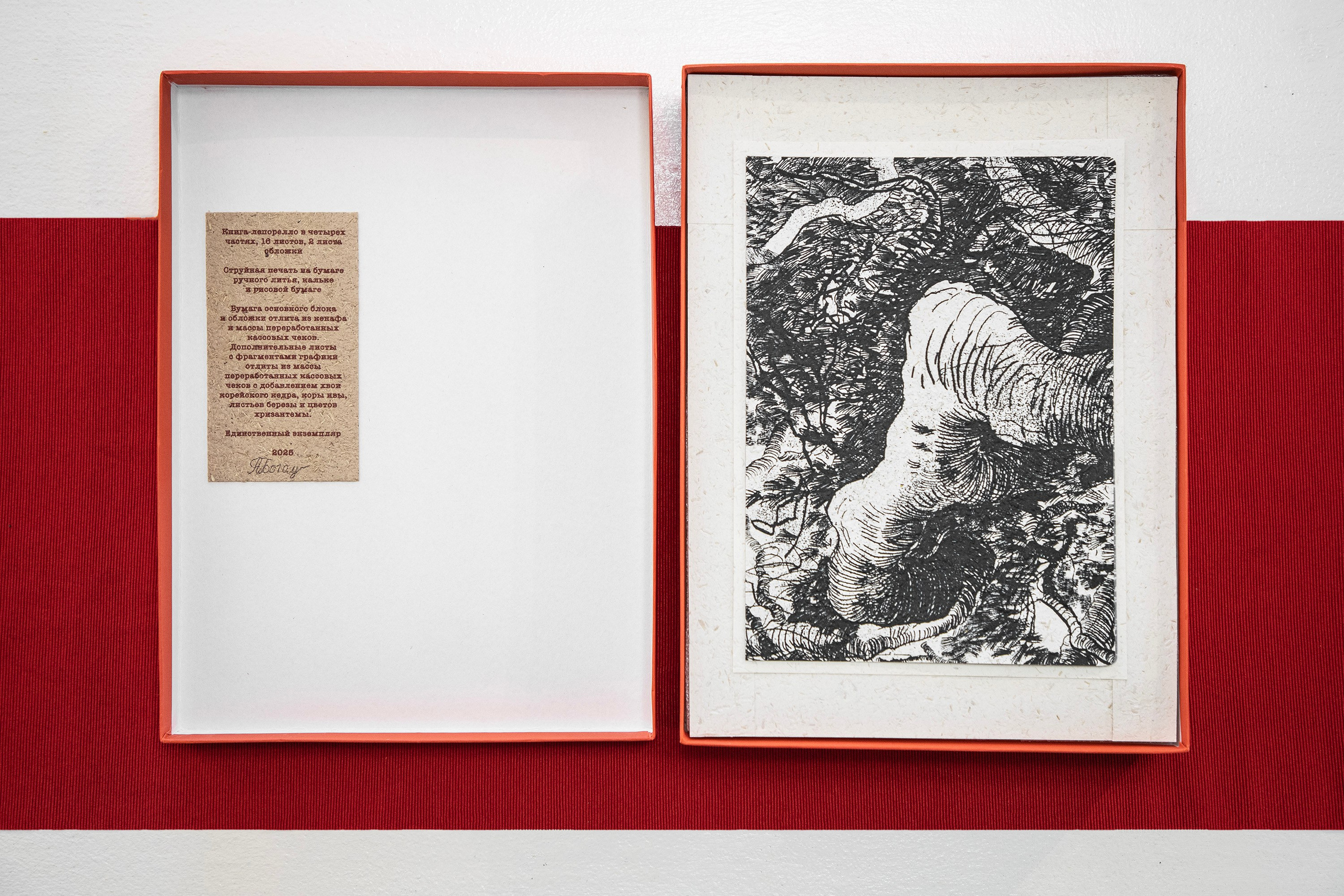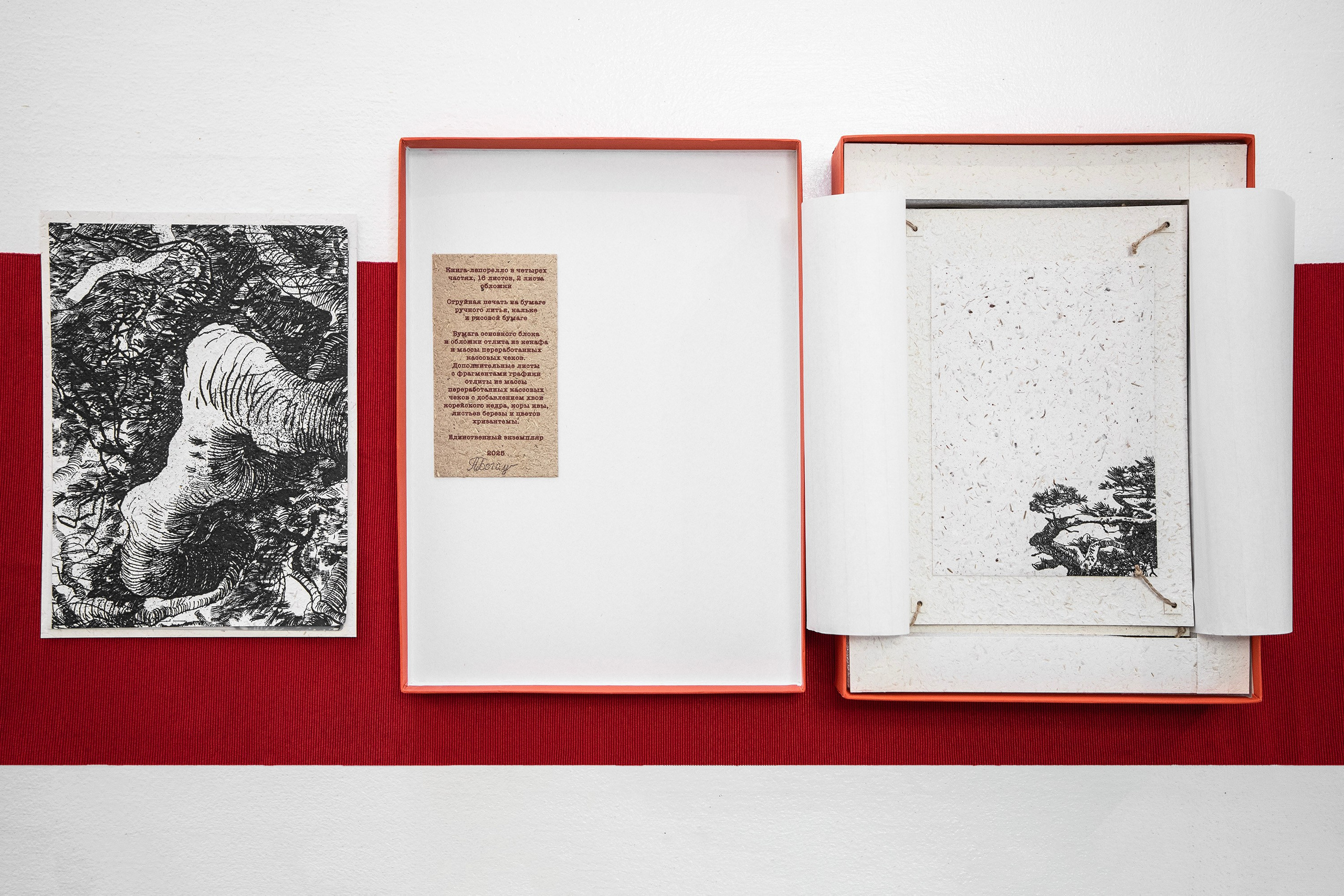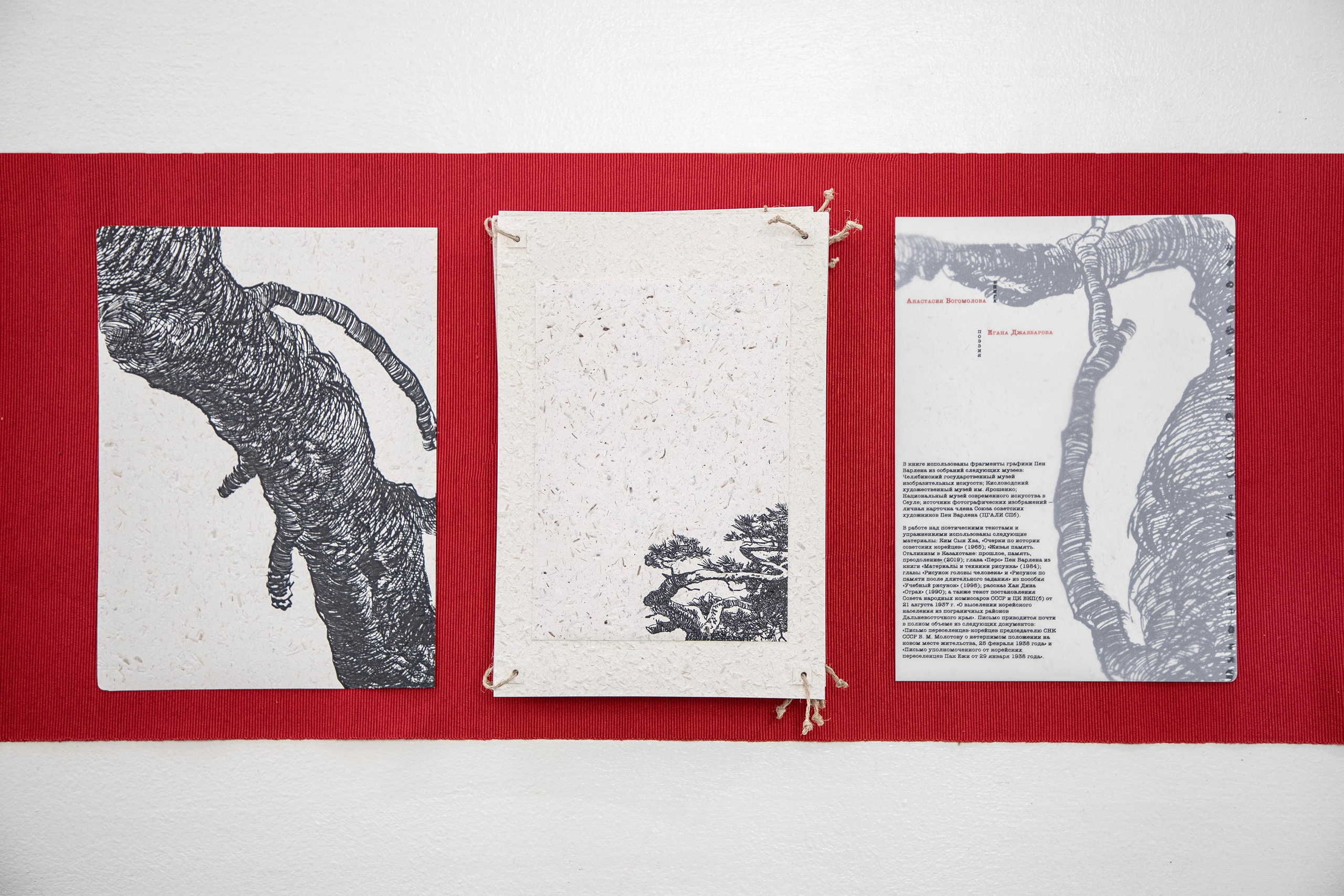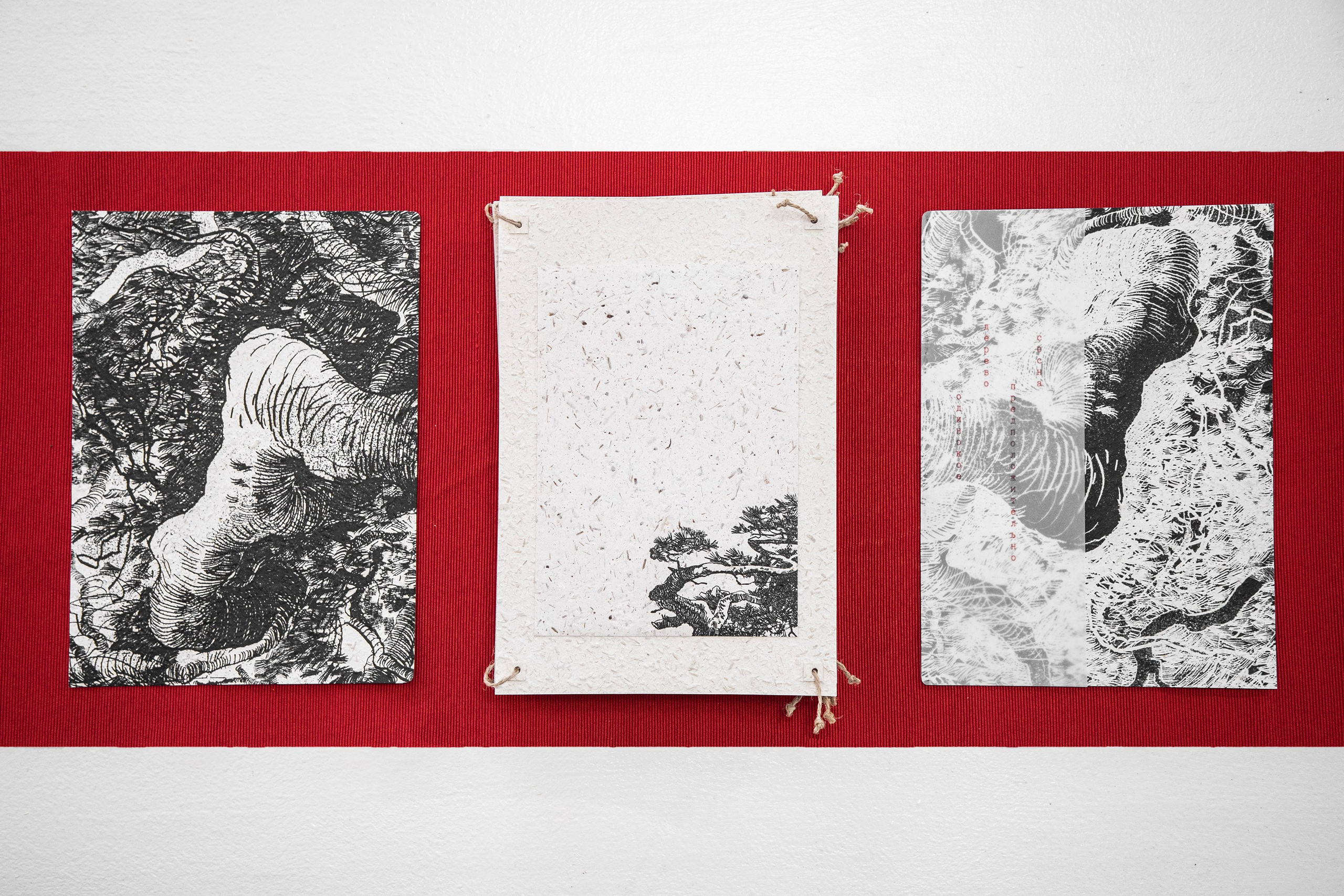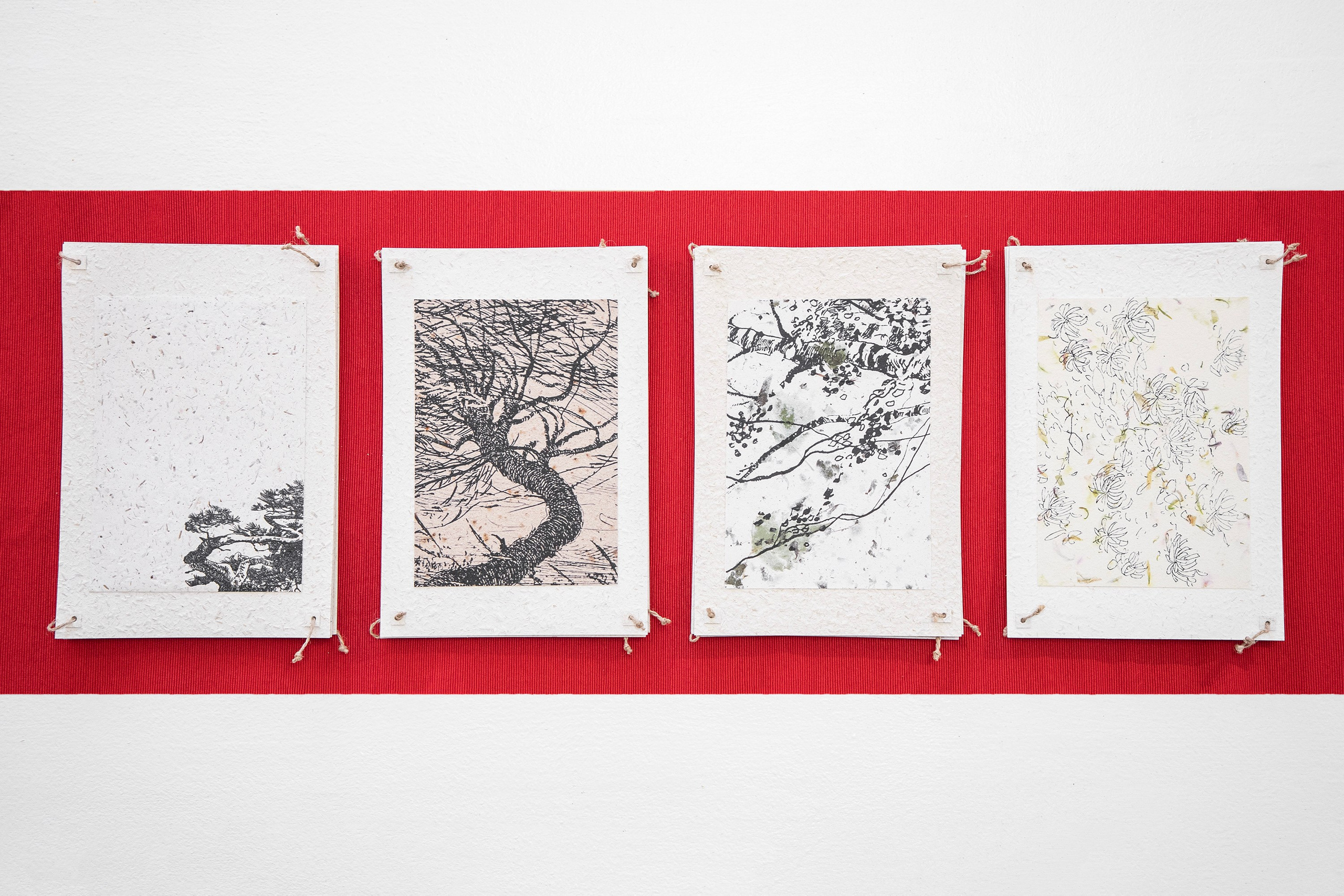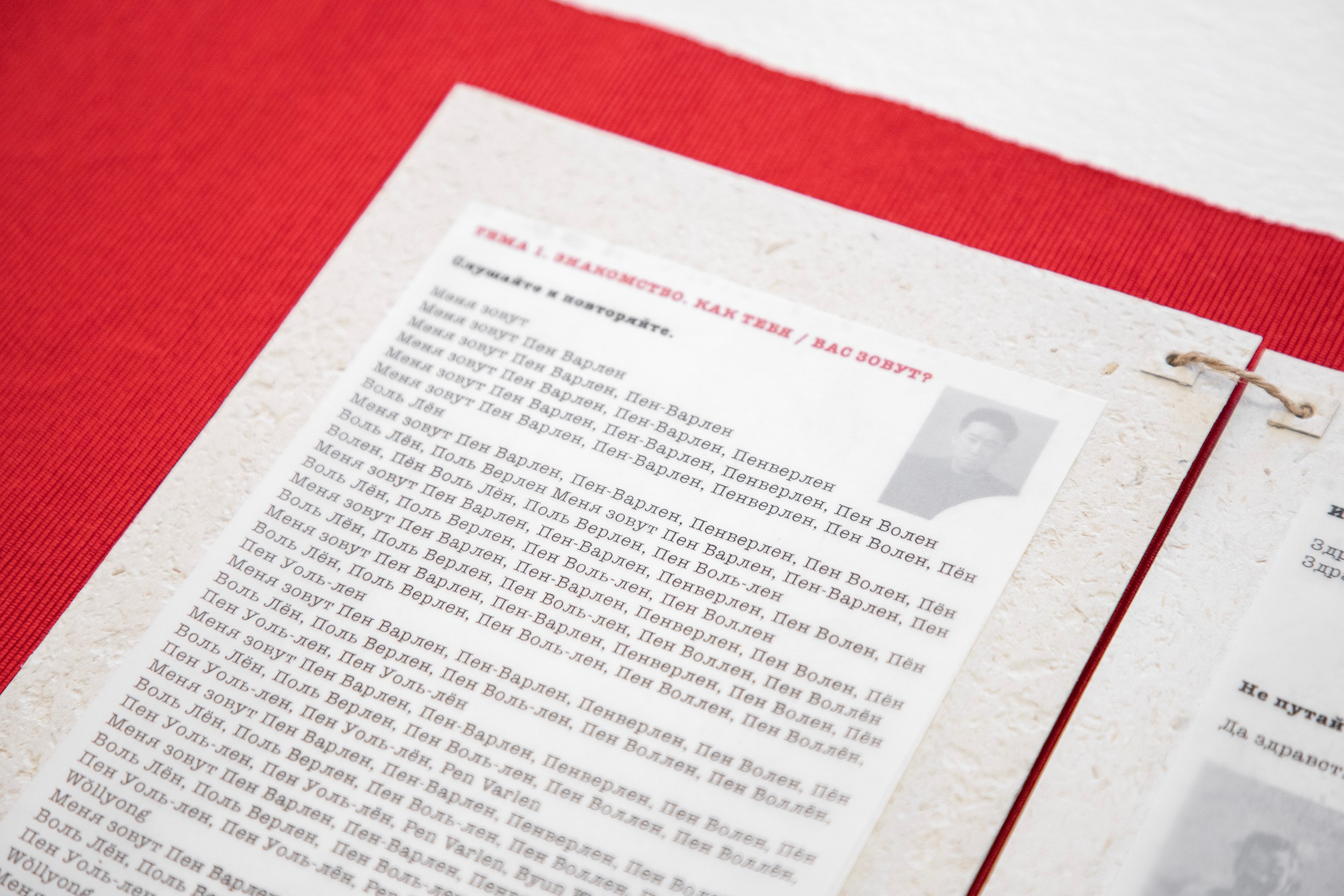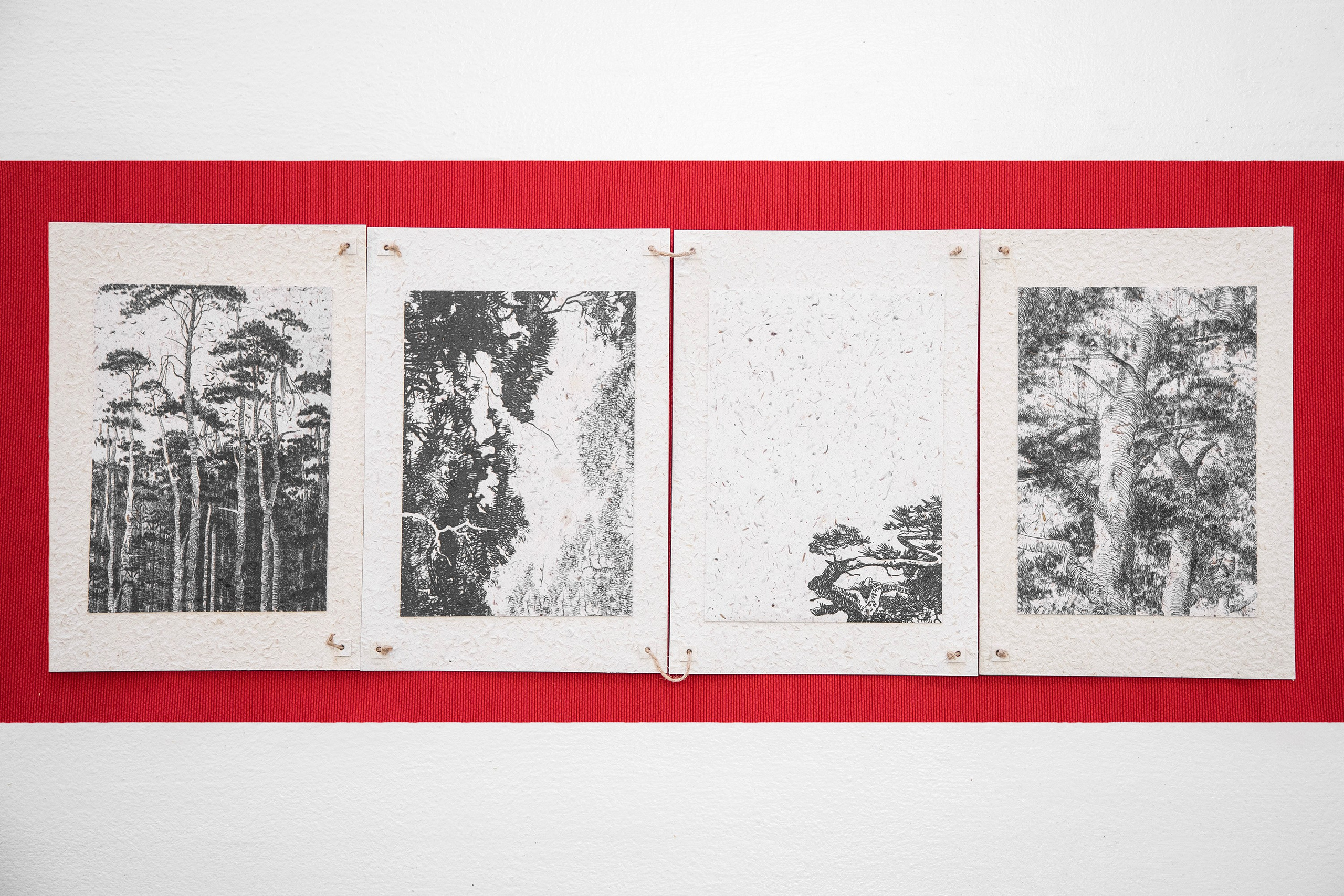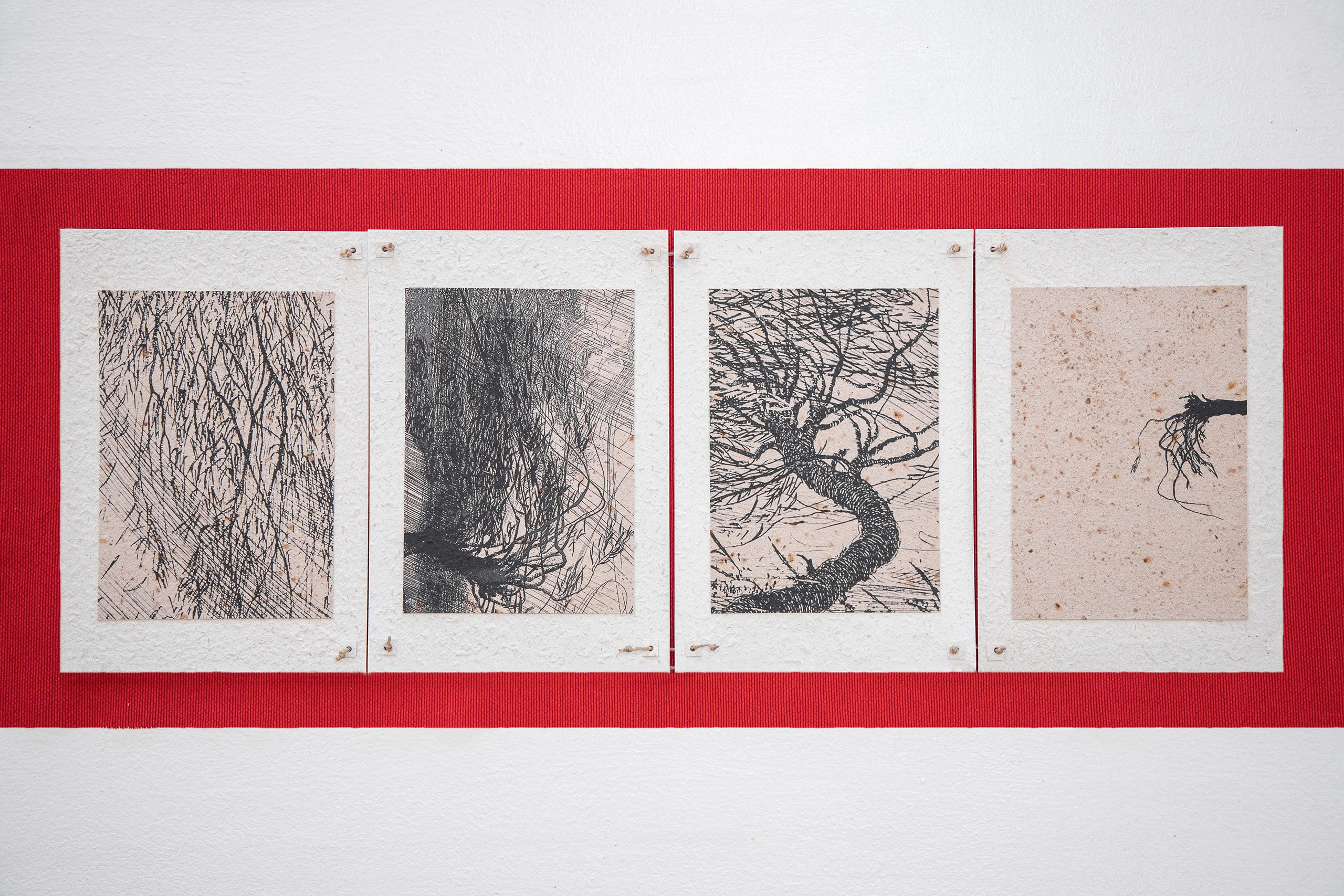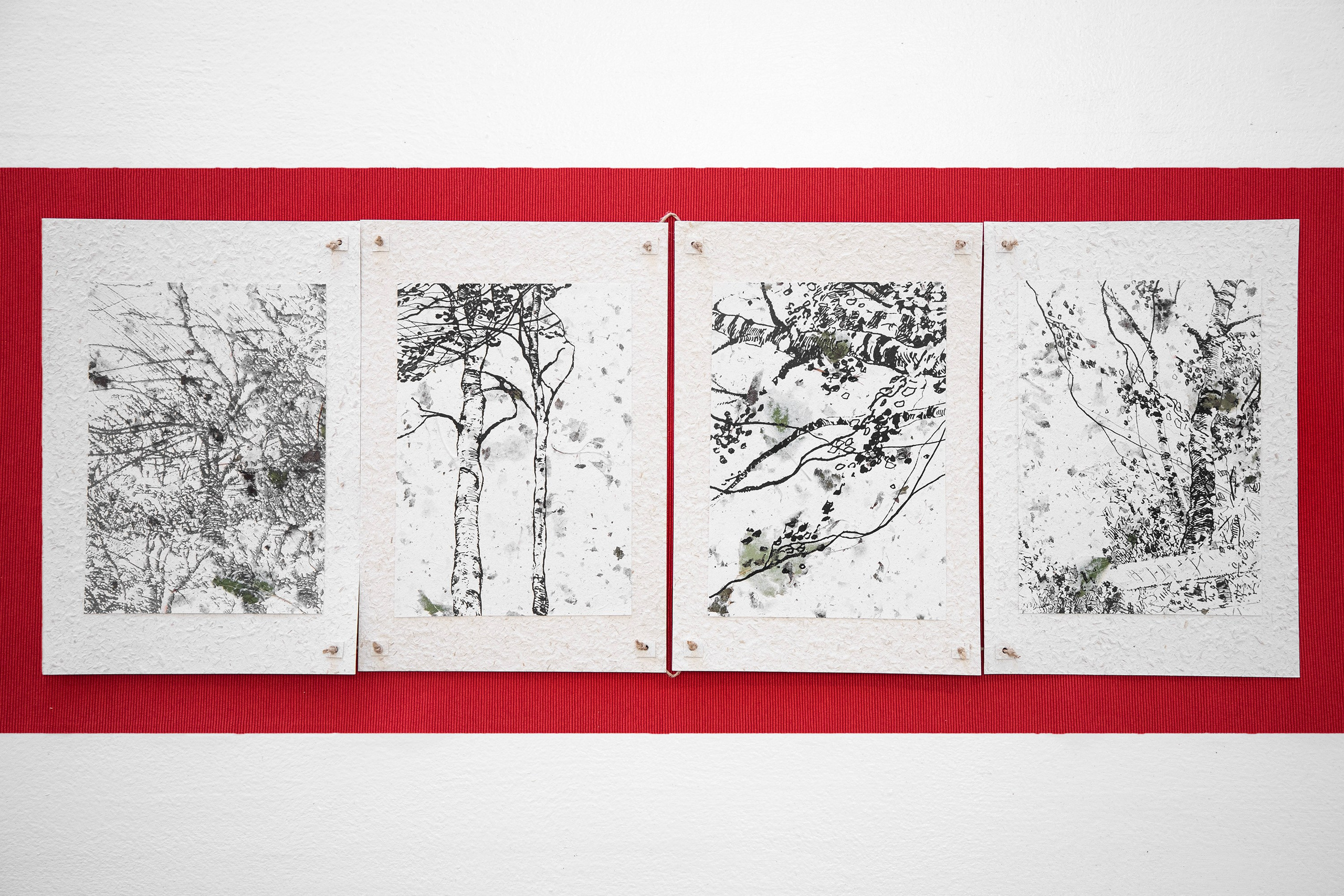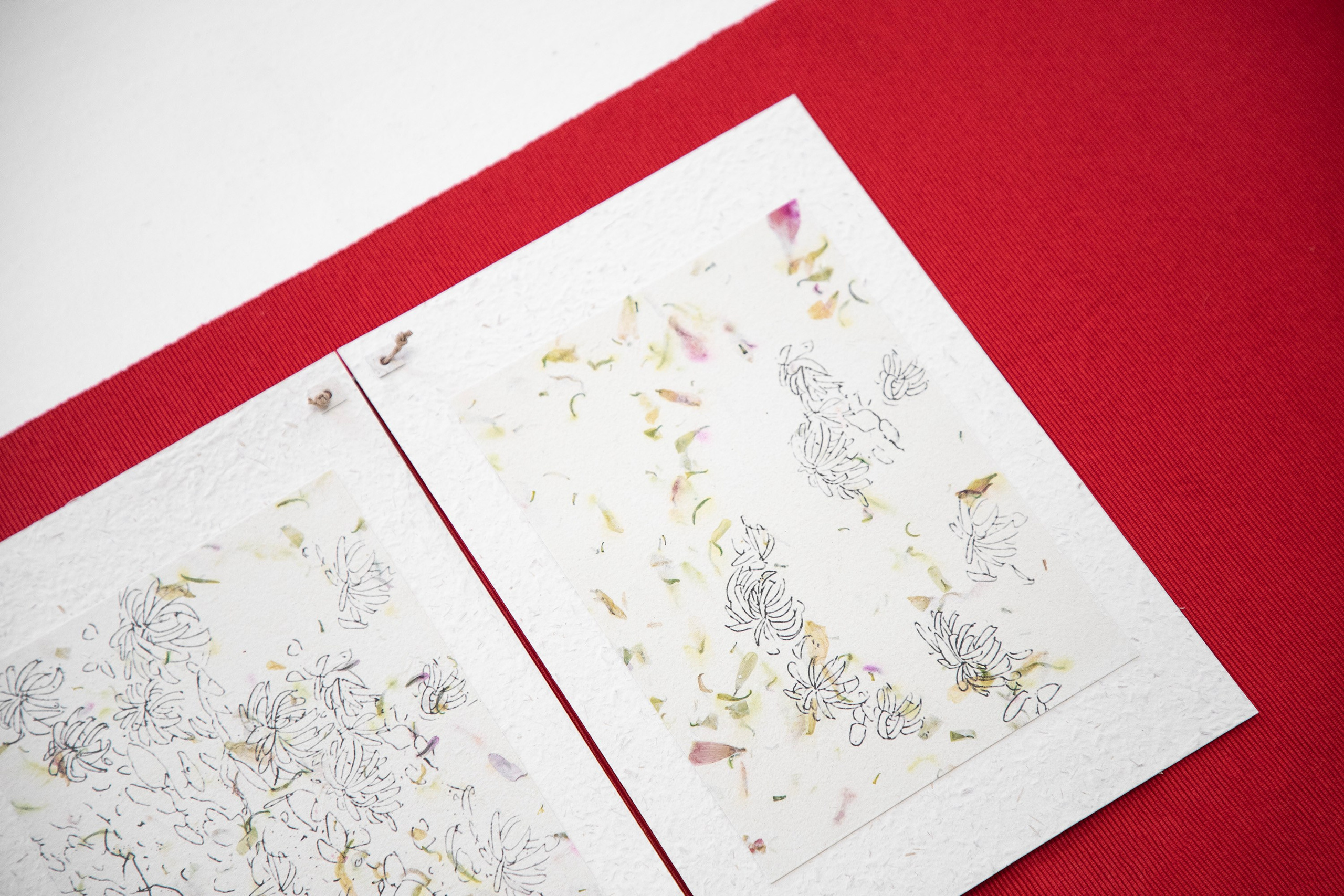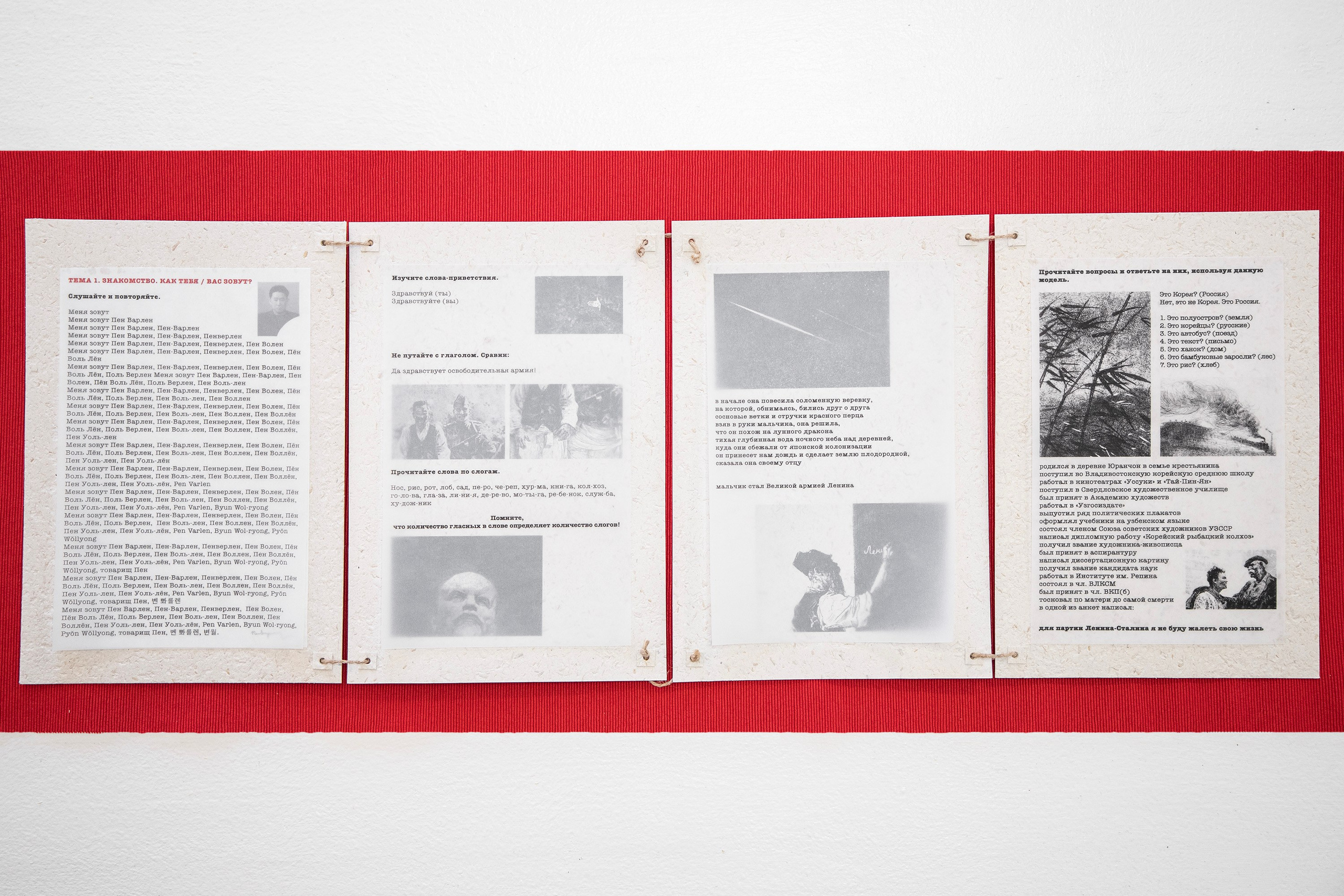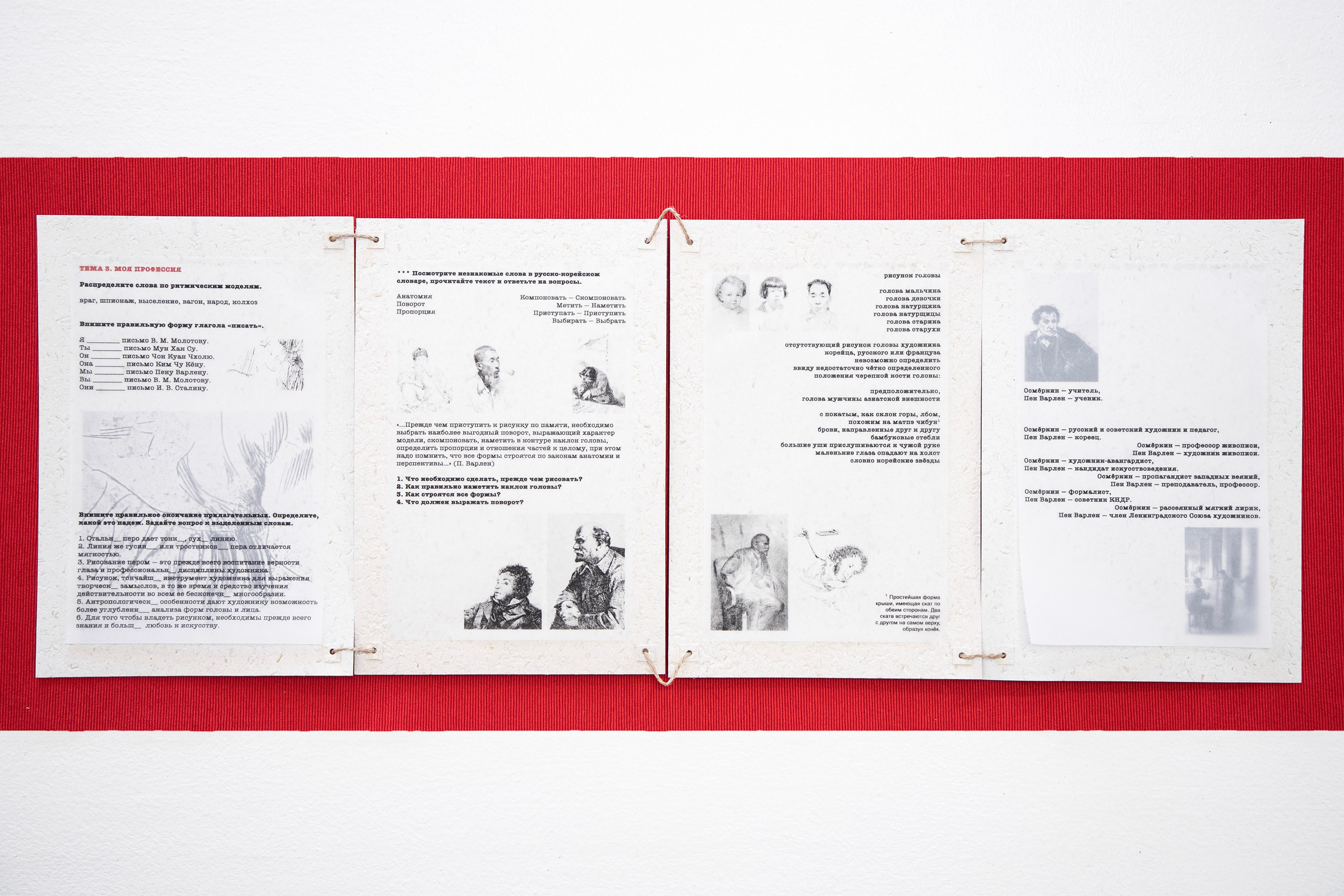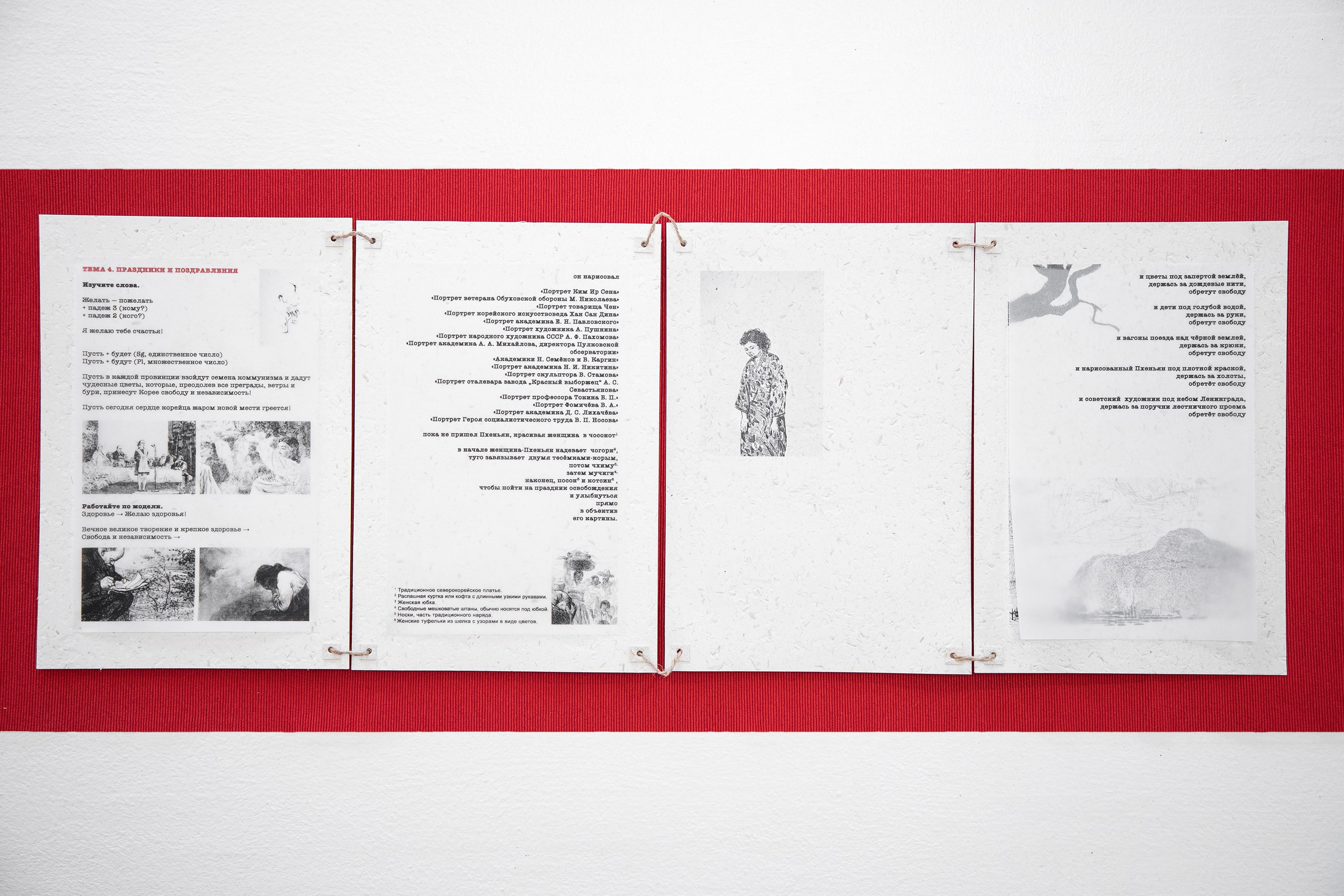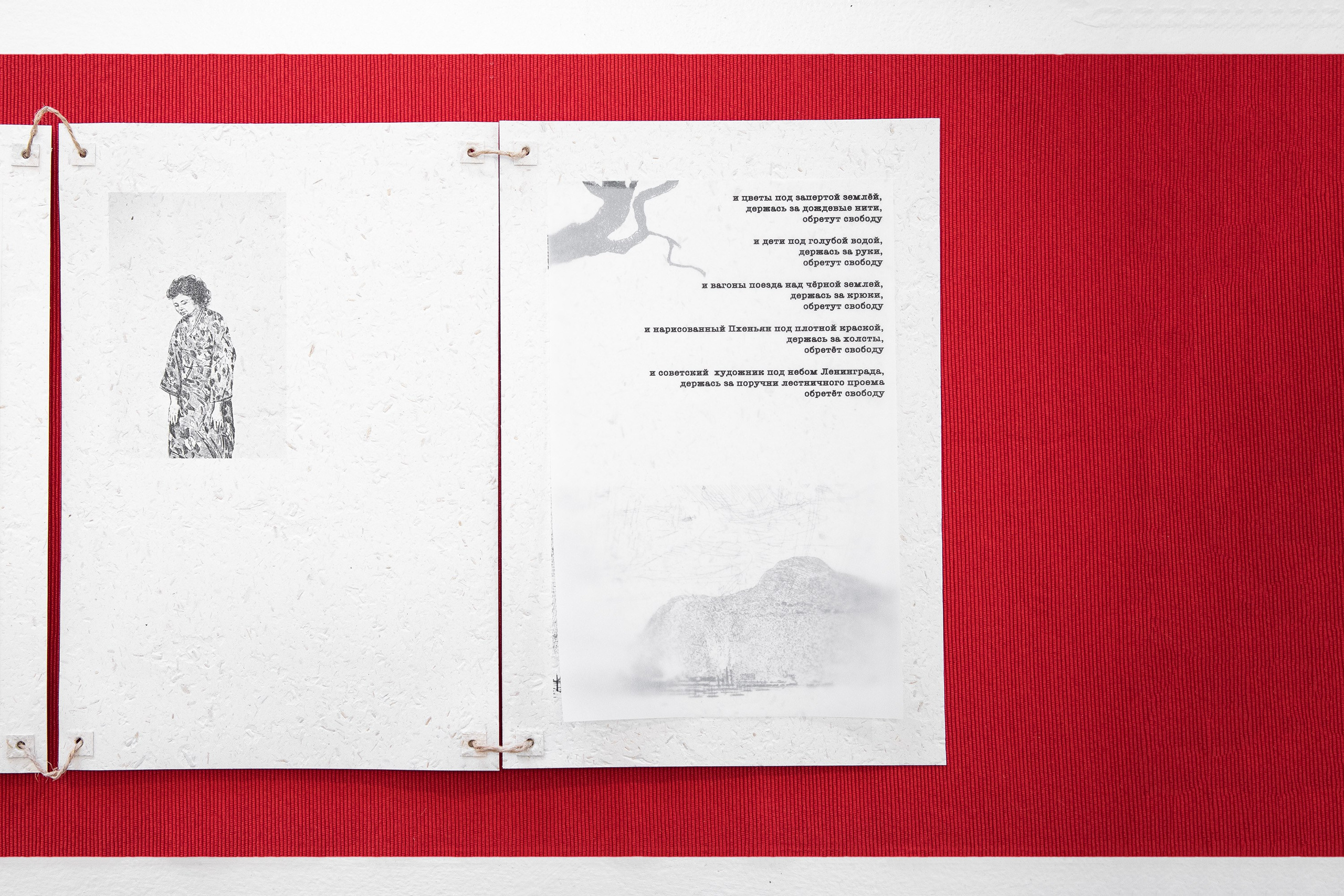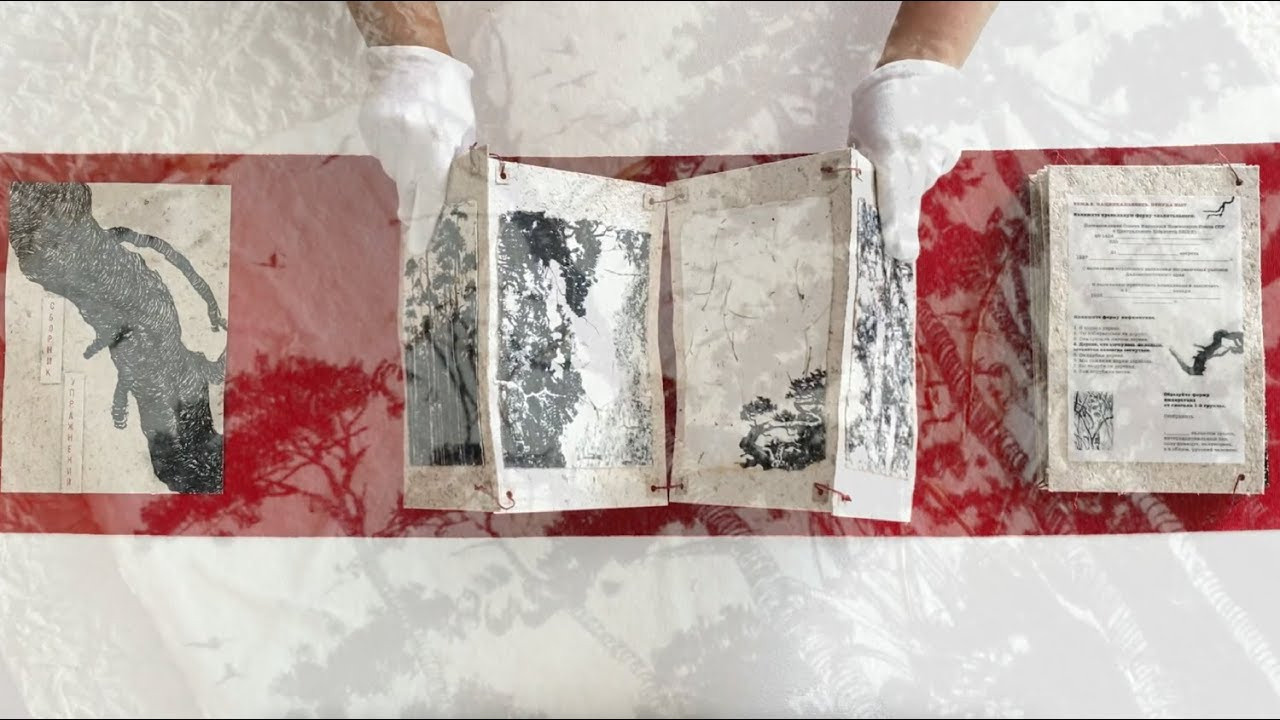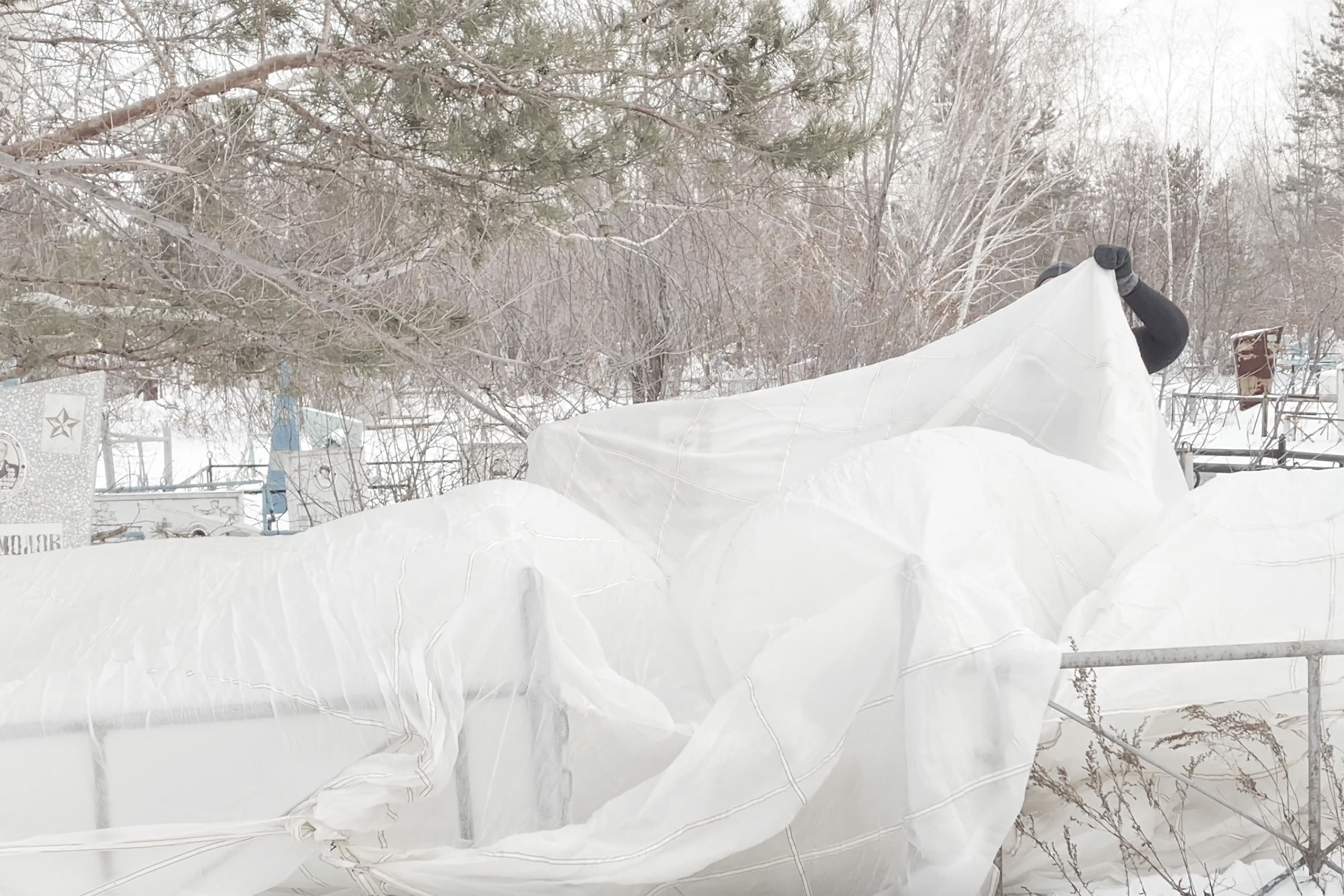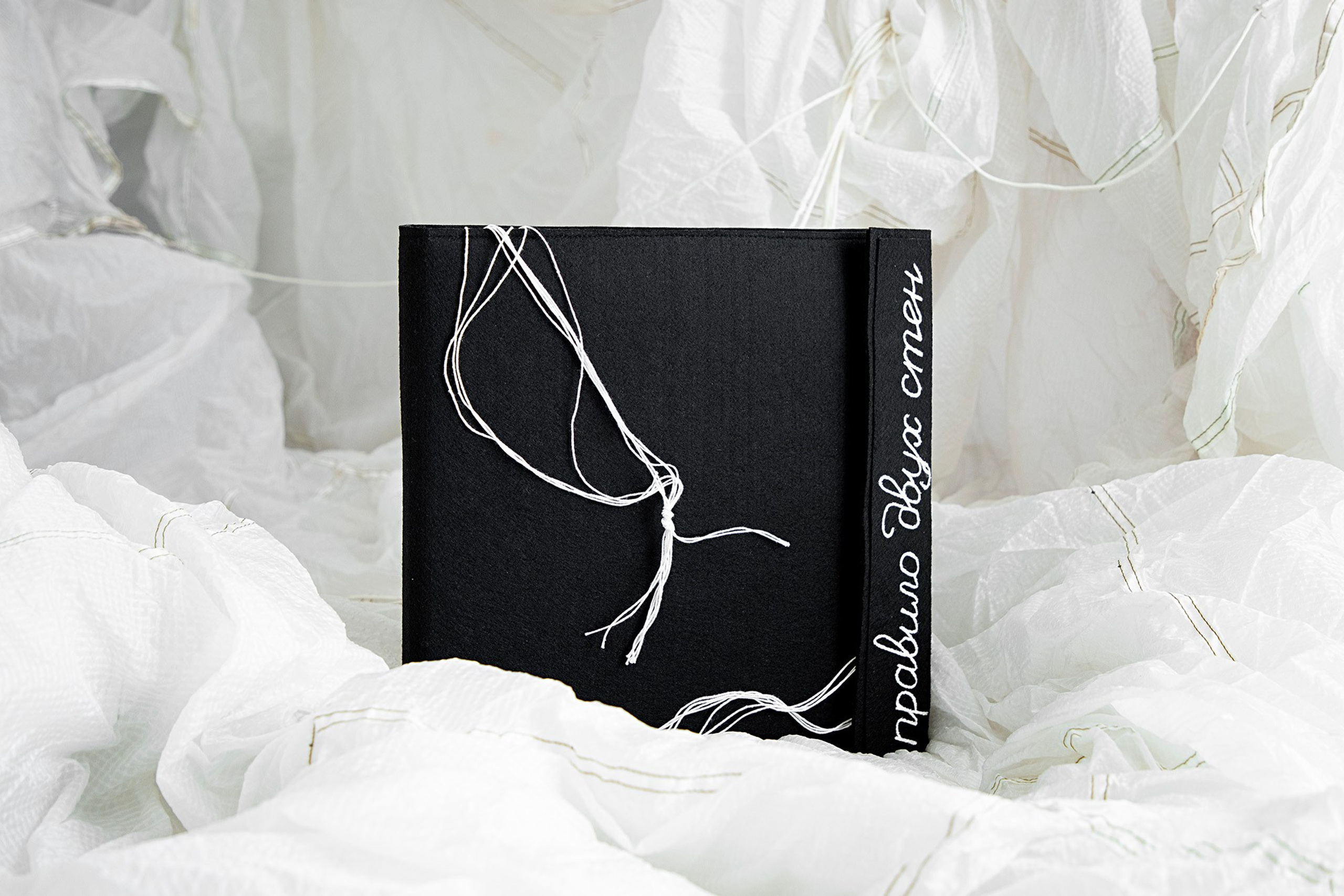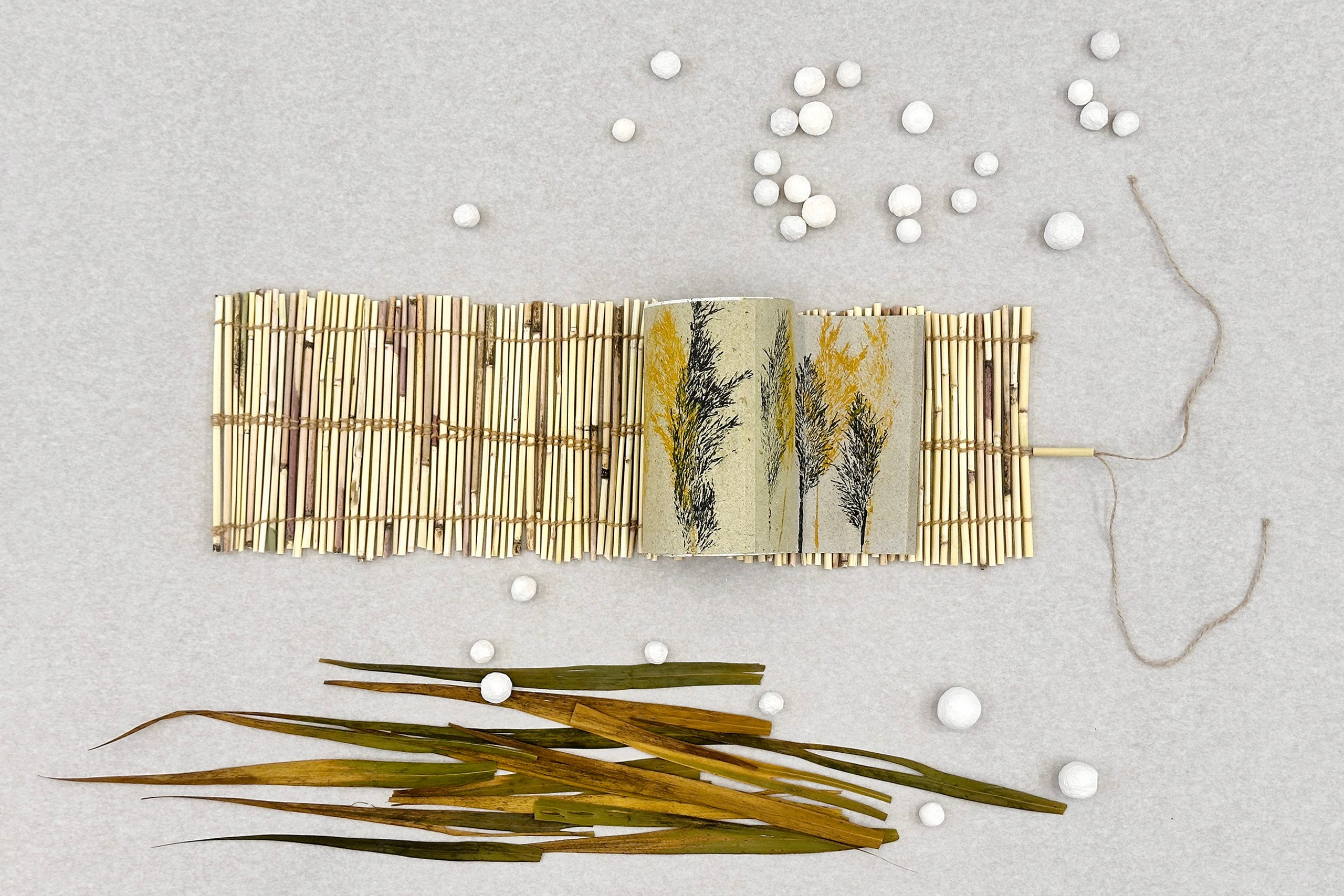A COLLECTION OF EXERCISES (2023)
Artist book. Edition: 1 copy. Leporello, 16 sheets and two sheets of cover. Handmade paper from kenaf and cotton with the addition of Korean cedar needles, willow and birch leaves, as well as chrysanthemum flowers. Printing on tracing paper and rice paper
The project was created for the MMCA Residency Changdong, an international program for artists and researchers run by the National Museum of Modern and Contemporary Art in Seoul, South Korea.
Poetry and exercise texts: Egana Cabbarly
Curatorial text: Svetlana Shlyapnikova
Translation of poetic texts: Maria Bikbulatova
Translation of curatorial text: Anya Litovskikh
Source of the fragments of graphic works by Pen Varlen: collections of the Chelyabinsk State Museum of Fine Arts, the Kislovodsk Art Museum named by Yaroshenko, National Museum of Modern and Contemporary Art (Korea); the source of photographic images is the personal record of a Soviet Artist Union member Pen Varlen (Central State Archive of Documents on Personnel of Liquidated State Enterprises, Institutions, Organizations of St. Petersburg).
The following materials were used in working on poetic texts and exercises: Kim Seung Hwa, “Essays on the History of Soviet Koreans” (1965); “Pen” by Pen Varlen from the book “Materials and Techniques of Drawing” (1984); “Drawing of a human head” and “Drawing from memory after a long task” from the manual “Educational Drawing” edited by V. O. Eremeev, V. A. Korolev (1995); Han Ding’s story “Fear”; “Living memory. Stalinism in Kazakhstan: past, memory, overcoming” (2019); text of the Resolution of the Council of People’s Commissars of the USSR and the Central Committee of the CPSU “On the eviction of the Korean population of the bordering territories of the Far East” dated August 21, 1937. The letter is quoted almost in full from the following document: Letter from Pak Ezhi, the representative of the Korean immigrants, p. Khorokhol, Denginsky district, Guryev region, to the Chairman of the Council of People’s Commissars of the USSR V. M. Molotov on the situation of resettled Koreans in Western Kazakhstan, dated January 29, 1938 “.
The soundtrack of the book trailer uses fragments and sound from the documentary film “Collective Farm Avangard” (Alma-Ata Film Studio, directed by I. Vereshchagin, 1946).
어려서 굽은 나무는 자라서도 굽은다.
“A tree that bowed young will stay bowed forever” — this vivid expression is used in the Korean spelling book for adults titled “The Red Infant” (1924). What did this succinct phrase mean for the Koryo-saram — Koreans who had to leave their homeland and settle in Primorye, only to be deported to Central Asia in 1937, under the pretext of “preventing infiltration of Japanese espionage into the Far-Eastern krai”? The first-ever Korean textbooks were published in the USSR in 1924–1937. While transmitting national Korean cultural codes, they also carried out the publishers’ objective of introducing soviet ideology into Koryo-saram consciousness. The forming of the “right ideas” about soviet reality within the minds of displaced Koreans is resembling of a gradually warping tree.
Anastasia Bogomolova, working in collaboration with poetess and writer Egana Cabbarly, uses a textbook format as a reference for their book about Pen Varlen (1916–1990), a soviet artist and pedagogue of Korean descent, whose lifepath had reflected the vicissitudes of the Koryo-saram people’s fate. The format of a textbook, on the one hand, determines structural organization and relationships within the plot of A Collection of Exercises, and on the other — allows us to see Pen’s personal story as a part of a bigger historical narrative. The textbook refers to the artist’s biography (his Korean school used such textbooks in the 1920s; according to one source, Pen, having shown artistic talent early, illustrated books published by Dalgis in the 1930s) and to the educational system, within which Koreans were made members of the “family of socialist peoples”.
A Collection of Exercises becomes a tool that authors use to pave the way toward a conversation on ideological indoctrination and the Soviet “orthopedics” of peoples. It wasn’t enough for Koreans to be loyal to the Soviet state — they had to undergo complete Sovietization, seize speaking their national language, and forget about the roots of their culture. This is what the Korean textbook proverb symbolically refers to. “A tree that bowed young will stay bowed forever”. The subtext points to the trauma of “readjustment” experienced by the diaspora.
Egana Cabbarly (who teaches Russian as a foreign language by profession) has formally and methodologically structured the texts within the book as exercises accompanied by poetic texts. The biography of Pen Varlen, which is inextricably linked to the history of the Korean diaspora in the USSR, is presented through a series of assignments and lesson topics: Introduction. What is your name?, Nationality. Where are you from?, My Profession, Celebrations and Gratulations. The division between “exercises” and poetic texts is nominal and almost nonexistent — the book reads as a uniform poetic text.
“My name is Pen Varlen, ” — states the opening sentence of A Collection of Exercises. The first topic of the book is Introduction. What does one’s notion of oneself begin with? The task is to “listen and repeat”, and the suggested text is the artist’s name listed in different variations of use, pronunciation, and spelling, filling the whole page. The list includes the name given to him at birth — Wol-ryong, which translates from Korean as “Moon Dragon”. At some point, it was turned into the Soviet Varlen, an abbreviation for “Lenin’s Great Army” (“Velikaya armia Lenina”). As an artist, Pen Varlen signed his graphic works in Hangul, thus reclaiming his identity.
Pen Varlen’s figurative understanding of the world and his system of belief had formed within two different cultural environments; he went through the dismantlement of the national and artistic languages, and this “distortion” manifested itself in his artistic practice and teaching. Growing up in Primorye, he spoke Korean and studied drawing with a Chinese calligrapher; later, he received artistic training at the Sverdlovsk Specialized School of Fine Arts (now the Yekaterinburg Specialized Art School named after Shadr) and at the Leningrad Academy of Painting, Sculpture, and Architecture named after Repin, where he received an academic degree in Art History. In Leningrad, he spoke, wrote, and taught in Russian. In his Artist Union application form, he stated that he knew two languages of the peoples of the USSR — Russian and Korean, but did not know foreign languages.
Upon graduation, he worked within the European canons of art. However, his practice was influenced by a year-long teaching assignment to North Korea in 1953, where, in the museums of Pyongyang, he became acquainted with the works of the founder of the national realistic landscape of Korea, Chong Seon (Kyomjae, 1676–1759), and a trip to Beijing in 1954, where he studied history and technique of traditional Chinese painting. At this point, symbolic landscape and depiction of trees as a separate genre are introduced into his practice. Exposure to the aesthetic tradition of Korean painting, with its refined perception of plant forms and organic fusion with nature, contributed to the change in style of Pen Varlen’s works.
The allusion to traditional genres of painting as an important part of Korean culture and worldview is manifested in the constructive solution of the Collection of Exercises. The second structure-forming reference for the book is sagunja — the “Four Noble Ones”. Instead of traditional sagunja plants (plum, orchid, bamboo, and chrysanthemum), Anastasia Bogomolova uses images of Korean pine, willow, birch, and chrysanthemum, borrowing these motifs from Pen Varlen’s printed graphics and linking their symbolism to the events of the artist’s life. The plants become part of the book, vicariously and literally: Anastasia Bogomolova uses them as materials in making their hand-cast paper. Leaves, needles, and flower petals create original textures and organically complement printed compositions. The material in the book contains another plant that is connected with Koryo-saram history — Hibiscus cannabinus, or kenaf, which is an economic crop, unlike the decorative Syrian hibiscus — the national symbol of Korea. Displaced Koreans were the ones who started to grow kenaf on their collective farms in Central Asia.
The pine tree is the symbol of the Introduction chapter. In Korean poetry, the pine tree embodies the eternal and the constant of the world, perseverance, and loyalty to one’s principles — as personal qualities. Bogomolova correlates the pine tree to the image of Pen Varlen — this chapter is dedicated to the name and origin of the artist.
Willow symbolizes parting: it is customary to break off a willow twig and give it to the person departing. The chapter Nationality is devoted to the deportation of Koreans in the Soviet Union. In her text, Egana Cabbarly uses documents: the decree of August 21, 1937 “On eviction of the Korean population of the bordering territories of the Far East” and a letter to the Chairman of the Council of People’s Commissars “on the forlorn condition and extremely difficult life situation” of displaced people on Kazakhstan lands unsuitable for agriculture, on the lack of fresh water and deaths from starvation. Texts and images in the book are layered: through the semi-transparent writing of displaced peoples, printed on tracing paper, the slogan reads: “The hearts of all Soviet Koreans are filled with deep gratitude towards the Communist Party, towards the Soviet government, towards the Russian brothers, with whom the Koreans have been bound by strong, unbreakable friendship for 100 years”. Texts with directly opposing meanings collide, revealing the dissonance between propaganda statements and the real state of affairs in the Soviet Union. The tragical narrative in this part of A Collection of Exercises is matched with a selection of fragments of Pen Varlen’s graphics: a willow tree is depicted in a moment of storm, curved under gusts of wind.
The “Russian tree” — birch (chapter My Profession) addresses Pen Varlen’s switch from one language (national and artistic) to another. The birch within the artist’s graphic works is associated with the Soviet and, more broadly, “Russian” subjects, with Lenin and Pushkin. In A Collection of Exercises, the tree also alludes to the teacher figure of the avant-garde artist Alexander Osmerkin. In this chapter, Egana Cabbarly builds the narrative with quotes from instructional texts by Pen Varlen and poems that address images within the artist’s drawings and juxtapose the roles of the master and the student.
The Chrysanthemum — a symbol of perfection, spiritual purity, and honor — becomes the embodiment of the theme of Celebrations and Gratulations. Korean poets often identified the chrysanthemum with their homeland. Egana Cabbarly includes a detailed description of a painting by Pen Varlen in one of her texts: a woman in a national costume is getting ready to go to a celebration in Pyongyang. The book ends with a symbolic poem about finding freedom.
Anastasia Bogomolova’s Collection of Exercises is a complex object, with each element conceptually thought out and aesthetically precise. The two cover sheets contain fragments of graphics by Pen Varlen. Each of the four inner blocks consists of four sheets that are bound to create a leporello fold, forming double-sided spreads. One side contains images of plants, and the other — visual narratives compiled of Pen’s graphic works, exercise texts and poems by Egana Cabbarly. For the pages with text, the artist uses three types of paper: hand-cast, rice, and tracing paper.
The paper for the book is made from recycled materials — a reference to the shortage of materials during the years when the Korean textbooks were published. The translucent effect of tracing paper, which blurs the lower layers, allows for the figurative field of the page to become a space for banding the known and hidden narratives, ambiguities, and uncertainties within the life of Pen Varlen. The material expression of A Collection of Exercises, poetic texts and documents, hand-made material, and the smell of paper made with plants and flowers, precisely chosen means of expression and technology create a three-dimensional, polyphonic sound of the life story of the Koryo-saram artist and pedagogue Pen Varlen.
Svetlana Shlyapnikova
Bibliography
1. 붉은아이. 로력학교용새독본. 대 1권. 대 2편. 블라지워스똑, 1924 [A spelling book for adults “The Red Infant”, 1924]. Russian State Library.
2. Personal record of a Soviet Artist Union member Pen Varlen. Central State Archive of Documents on Personnel of Liquidated State Enterprises, Institutions, Organizations of St. Petersburg. F. 78. Op. 8. D. 386. L. 11.
3. Resolution of the Council of People’s Commissars of the USSR and the Central Committee of the CPSU. On the eviction of the Korean population of the bordering territories of the Far East. August 21, 1937 // Rodina. 1992. No. 10. P. 58. With reference: FSB Central Archive.
4. Letter from Pak Ezhi, the representative of the Korean immigrants, p. Khorokhol, Denginsky district, Guryev region, to the Chairman of the Council of People’s Commissars of the USSR V. M. Molotov on the situation of resettled Koreans in Western Kazakhstan. January 29, 1938 // GA RF. F. P-5446. Op. 29. D. 49. L. 7–8.
5. Uspensky A. Inner style. Etchings by Pen Varlen // Dialogue of Arts. 2007. No. 3. P. 36–38.
6. Filimonova E. N. Symbolism of plants in translated works. “Noble” plants (based on translations from Korean and Chinese) // Language, consciousness, communication: Collected articles / Chief ed. V. V. Krasnykh, A. I. Izotov. M.: MAKS Press, 2003. Issue. 25. pp. 26–53.
